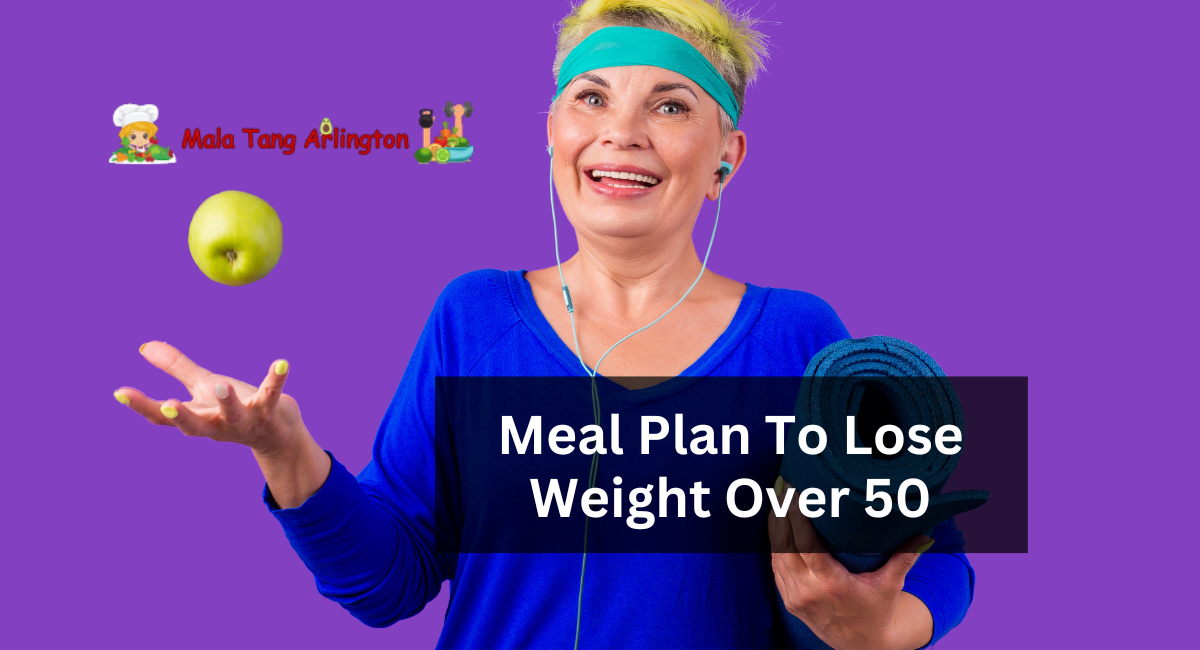Weight loss is challenging at any age, but people over 50 may require a different approach. Our nutritional requirements change as our bodies age.
In this article, we will present you with a customized meal plan designed to help people over 50 lose weight while maintaining maximum health.
Meal Plan To Lose Weight Over 50
A healthful meal plan should include the following items:
All Of The Major Food Groups
Fad diets, such as the ketogenic and raw food diets, may be effective in the short term.
However, if you’re looking for the finest diet for women over 50 that you can maintain for a lifetime, don’t remove food groups.
The following food groups should be included in well-balanced diets:
- A wide range of fruits
- Leafy greens, celery, tomatoes, cucumbers, broccoli, and other non-starchy vegetables
- Sweet potatoes, corn, peas, beans, lentils, and other legumes are examples of starchy vegetables.
- Brown rice, wild rice, oatmeal, quinoa, whole-grain pasta, Ezekiel bread, and other whole grains
- Lean meats, chicken, turkey, fish, seafood, eggs, tofu, and seitan are examples of protein foods.
- Fats that are good for you (olive oil, fish oil, olives, avocados, nuts, seeds, and nut butter)
Filling half your platter with non-starchy vegetables, one-fourth of your plate with protein foods, and one-fourth of each plate with fiber-rich carbohydrates (whole grains, peas, beans, other legumes, etc.) is an excellent method to portion these nutritious whole meals.
Controlled Calories
Calorie control reduces the likelihood of unwanted weight gain in the future, whether you’re trying to lose weight or maintain your current weight.
For women over 50, the Dietary Guidelines for Americans 2020 propose the following calorie needs:
- 1,600 calories per day for sedentary people
- Moderate activity: 1,800 calories per day
- 2,000-2,200 calories per day for active people
If you want to lose weight, aim for 1,200 calories daily to lose 1-2 pounds weekly.
A Routine Meal Plan
When feasible, eat at regular meal times to minimize hunger (and overindulging at the next meal) and to maintain high energy levels throughout the day.
Eat every couple of hours or so.
You could choose three meals plus two smaller snacks or five to six meals with roughly the same number of calories.
Dietary Supplements
Dietary supplements are likely to be included in the ideal diet for women over 50 to guarantee you’re achieving your daily nutritional needs – especially if you’re decreasing calories for weight loss.
Consider the following supplements for ladies over the age of 50:
- Weight loss protein meal replacement shakes
- As needed, fiber supplements
- Omega-3 fatty acids for cardiovascular and cognitive health
- Probiotics for digestive, immunological, general, and mental health
- Multivitamins with all important vitamins and minerals to prevent deficits
- Supplemental calcium and vitamin D as needed
Before taking dietary supplements, always consult with your doctor.
Lots Of Water
Many women over the age of 50 do not drink enough water.
Everyone is different, but women over 50 should drink at least 12 cups of water or other fluids daily to stay healthy.
When you wake up, drink 2-4 cups of water, 2 cups before meals, and plenty before, during, and after workouts.
Drink ice-cold water or add fruit to it to increase flavor.
Other Ways To Lose Weight After 50
1. Learn To Enjoy Strength Training
Although aerobics is popular for weight loss, strength training is equally vital, especially for older folks.
Sarcopenia is a condition in which your muscle mass reduces as you age. Around age 50, you start to lose muscle mass, which can slow down your metabolism and make you gain weight.
Muscle mass diminishes by roughly 1-2% each year after the age of 50, whereas muscle strength declines by 1.5-5% per year.
Thus, incorporating muscle-building activities into your program is critical for preventing age-related muscle loss and maintaining a healthy body weight.
Bodyweight workouts and weightlifting, for example, can considerably improve muscle strength while also increasing muscle size and function.
Strength training can also help you lose weight by reducing your body fat and speeding up your metabolism, which can make you burn more calories throughout the day.
2. Collaborate
It can be difficult to establish a healthy eating habits or an exercise routine on your own.
Pairing up with a friend, coworker, or family member may help you keep to your plan and achieve your wellness goals.
For example, studies show that people who lose weight with their friends are much more likely to keep the weight off in the long run.
Working out with friends can also help to enhance your dedication to a fitness program and make exercise more pleasurable.
3. Move More And Sit Less
It is vital to burn more calories than you consume in order to lose excess body fat. That is why, when trying to reduce weight, being more active throughout the day is essential.
For example, sitting at your desk for long periods may sabotage your weight loss attempts. To combat this, even getting up from your desk and taking a five-minute stroll every hour will help you become more active at work.
According to research, wearing a pedometer or Fitbit to count your steps can help you lose weight by raising your activity level and calorie expenditure.
Start with a realistic step target using a pedometer or Fitbit based on your current activity levels. Then, depending on your overall health, progressively go to 7,000-10,000 steps per day or more.
4. Increase Your Protein Intake
Getting enough high-quality protein in your diet is important for both losing weight and stopping or correcting the muscle loss that comes with getting older.
Your resting metabolic rate (RMR), or how many calories you burn at rest, declines by 1-2% every decade after the age of 20. This is linked to age-related muscle loss.
A protein-rich diet, on the other hand, can help prevent or even reverse muscle loss. Increasing dietary protein has also been proved in numerous studies to help you lose weight and keep it off in the long run.
Furthermore, studies demonstrate that older persons have higher protein needs than younger adults, emphasizing the importance of including protein-rich foods in your meals and snacks.
5. Consult A Dietician
It might be hard to find a way to eat that helps you lose weight and gives your body what it needs.
A licensed dietician can assist you in determining the best approach to shed excess body fat without having to adhere to an unduly restrictive diet. A nutritionist can also support and guide you throughout your weight loss journey.
Working with a dietician to reduce weight can result in much better results than trying it alone, and it may help you maintain the weight loss over time, according to research.
6. Prepare More Meals At Home
Numerous studies have shown that those who cook and eat more meals at home have a healthier diet and weigh less than those who do not.
When you cook at home, you have full power over what goes into your recipes and what doesn’t. It also gives you a chance to try new healthy foods that catch your eye.
Start with preparing one or two meals each week at home, then gradually raise this number until you’re cooking at home more than you go out.
7. Consume More Fruits And Vegetables
Vegetables and fruits are high in nutrients that are essential for your health, and incorporating them into your diet is a simple, evidence-based strategy to lose weight.
A study of ten trials, for example, discovered that every additional daily serving of vegetables was connected with a 0.14-inch (0.36-cm) waist circumference reduction in women.
Another study of 26,340 men and women aged 35 to 65 found that eating fruits and vegetables resulted in lower body weight, waist circumference, and body fat.
8. Hire A Personal Trainer
Individuals can benefit a lot from working with a personal trainer, who are new to working out since they can teach you the proper manner to workout in order to encourage weight reduction and avoid injury.
Personal trainers can also push you to exercise more by holding you accountable. They might even change your mind about exercise.
A 10-week research of 129 persons found that one-on-one personal training for one hour per week enhanced exercise motivation and physical activity levels.
Losing weight after 50 is possible with the appropriate diet and lifestyle changes. Remember to contact with a healthcare practitioner before beginning any weight loss program, especially if you have underlying health issues. You can strive towards a healthier and more vibrant you with determination, careful eating, and this tailored meal plan.
Thanks for reading. I hope you find it helpful.










